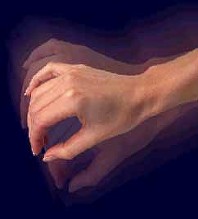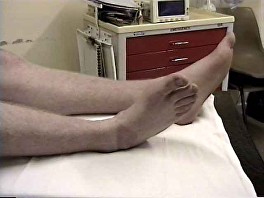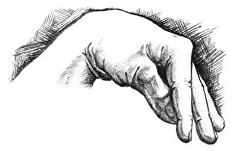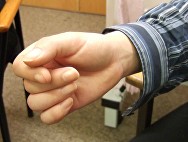Functional Tremor/ Dystonia / Walking Problems and Other Functional Movement Disorders
A functional movement disorder means that there is abnormal movement or positioning of part of the body due to the nervous system not working properly (but not due to an underlying neurological disease).
You can read about each of these symptoms in more detail on their own page (Functional Tremor, Functional Dystonia/Spasms, Functional Jerks/Myoclonus, Functional Gait Disorder), some people just have one type of movement disorder. Some have several.

 Patients with fixed dystonia often have a clenched hand (below) or an ankle that has twisted in (inverted ankle) – Video
Patients with fixed dystonia often have a clenched hand (below) or an ankle that has twisted in (inverted ankle) – Video

Patients with a functional movement disorder may experience a range of distressing and disabling symptoms:
Tremor – When an arm or leg shakes uncontrollably. In functional tremor this is often quite variable. It may even disappear when you are distracted but at other times be very disabling.
Jerks / Twitches – Some people experience jerky types of movements. This may be particularly in response to loud noises, certain kinds of lighting or bursts of pain
Spasm / Contractures / Dystonia – Some people find that their hands or feet develop abnormal postures which are hard to overcome. This may be a temporary intermittent problem (a spasm) or may be more chronic (this is usually called fixed / functional dystonia or contracture). Patients with functional dystonia often have a ‘clenched hand’ or a twisted foot (See opposite)
Gait problems – A variety of gait (walking) problems can occur as part of a functional illness. Most common is the ‘dragging’ gait seen in patients with functional weakness of one leg. Other types of gait include a generally unsteady gait, often associated with a history of previous falls and a heightened fear of future falls.
Unlike other movement disorders (e.g., Parkinson’s disease), a functional movement disorder is not caused by damage or disease of the nervous system. It is however due to a reversible problem in the way that the nervous system is working.
This means that a functional movement disorder can get better and even go away completely.
The diagnosis of a functional movement disorder is usually made by a neurologist. It can be a particularly difficult diagnosis to make because it requires expert knowledge of the full range of movement disorders due to neurological disease, many of which are unusual or even bizarre.
It is therefore difficult to summarise all of the clinical features of functional movement disorders. They often occur in relation to injury and the onset can be sudden. The following are some examples
Tremor (shaking) – typically a functional tremor is characterised by:
Jerks – this is called myoclonus. Functional myoclonus is characterised by
Benign Twitches – these are sometimes called ‘benign fasciculations’. Most people have small twitches from time to time, especially around the eye, in the fingers and in the calves. Such twitching is so common that to experience it occasionally is normal. However, some people find that they experience more and more of this muscle twitching until it is present in multiple areas of their body, for most of the time. This can lead to understandable anxiety about what is causing the symptoms, which in turn makes the twitching even worse. Generalised benign twitching like this is known to occur more frequently in medical students and doctors who, on developing these symptoms, worry that they might have motor neurone disease (known in the USA as ALS). In fact the twitching seen in this condition, which affects the whole muscle fibre, is different to the smaller wriggling movements, called fasciculations, seen in motor neurone disease. The condition is therefore somewhat misnamed as benign fasciculation. There are other causes of generalised muscle twitching but benign fasciculation remains the most common clinically.
Spasms – Functional spasms are called ‘dystonia’. They often occur in the hand and wrists. The hand may go in to something called ‘carpopedal spasm’. (see picture). This does occur with other medical conditions too such as having a low blood calcium and your doctor should consider these before deciding they are ‘functional’. Carpopedal spasm is especially likely to occur during hyperventilation (click here to find out more).
Fixed posture (functional dystonia) – This describes a position, usually of the hand or feet which remains fixed for all or most of the time. Fixed postures like this are usually associated with some functional weakness of the limb and commonly associated with pain. There is an overlap here with a condition called Complex Regional Pain type 1 . The two most common types are:
Functional Gait Disorder – There are various types of functional gait disorder. describes difficulty walking (an abnormal gait) which is not due to an underlying neurological disease. Different types have been described including:
Functional movement disorders arise for different reasons in different people. Some of the apparent precipitating factors are similar to those described for functional limb weakness especially:
After an injury / with pain—A high proportion of patients with functional dystonia (and to a lesser extent tremor) have a physical injury or a painful limb at the time of onset. There is an overlap here with a condition called Complex Regional Pain . The movement disorders seen in this condition (especially the dystonias) are indistinguishable from those described as functional movement disorders. Functional jerks and tremors also occur in patients with chronic pain syndromes such as back pain and neck pain.


We will be re-directing you to the University of Edinburgh’s donate page, which enable donations in a secure manner on our behalf. We use donations for keeping the site running and further FND research.
